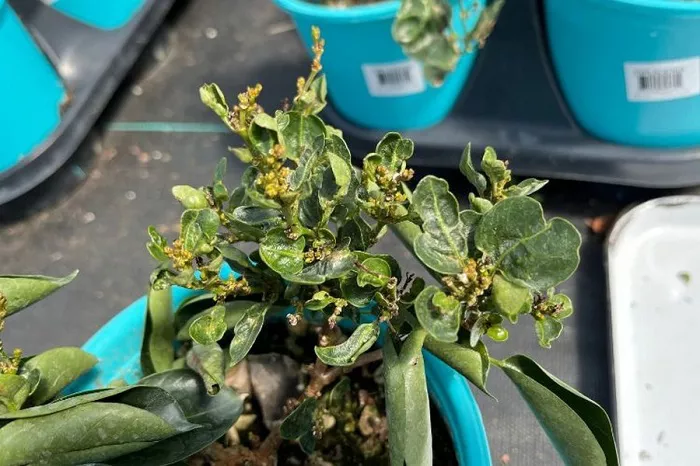Over the past few years, Michigan greenhouses have seen the emergence of an invasive pest known as Thrips parvispinus, commonly referred to as pepper thrips, Taiwanese flower thrips, or tobacco thrips. This species, first detected in Florida in July 2020, has since spread to at least seven other states and has been intermittently found in Michigan greenhouses since 2023.
Appearance and Origin
Pepper thrips can be distinguished from the more common western flower thrips by their unique appearance. They have a dark head, beige thorax, black abdomen, and yellow legs. Females appear two-toned, with a distinct partition between their dark abdomen and light-brown head and thorax, making them easily recognizable. Males are about half the size of females and are uniformly yellow or light brown. Originating in Thailand, this species has spread globally through the movement of plant material.
Potential Impact on Michigan
In its native Thailand, pepper thrips have caused significant crop losses in peppers, raising concerns about its potential impact on Michigan’s floriculture industry. These thrips feed on leaves, flowers, and fruit, causing severe deformation and extensive brown scarring on young foliage and new growth. Affected tissue often becomes brittle and puckered, resembling damage caused by broad mites. In many cases, plants become stunted and misshapen, rendering crops unsalable.
Life Cycle and Symptoms
Understanding the life cycle of Thrips parvispinus is crucial for managing its impact. Under typical greenhouse conditions, this species completes its life cycle in 13 to 14 days, with two to three days spent beneath the soil surface as prepupa and pupa. This is slower than the more common western flower thrips. Female T. parvispinus lay around 15 eggs, far fewer than western flower thrips, typically in bract leaves, leaving small, round brown spots on flowers as a telltale sign. After hatching, larvae go through two molts over four to five days before reaching maturity. Pupation occurs in the soil at a depth of about 1 inch. Adult females live for approximately nine days, while males typically survive about six.
Research Efforts
Alexandra Revynthi, PhD, at the University of Florida is leading a comprehensive research initiative to better understand and manage Thrips parvispinus. Her team is working with government agencies and private industry partners to identify effective strategies for controlling this pest.
Current Findings and Management Recommendations
Chemical Control: Researchers evaluated the efficacy of both conventional insecticides and biopesticides. A total of 21 conventional products and 11 biopesticides were tested. Some compounds, like Mainspring, impact thrips by impeding their ability to feed, resulting in death by dehydration or starvation after several days. Botanical oils like garlic, sesame, and thyme, along with mineral oils and insecticidal soap, consistently limited visible crop injury.
Microbial Insecticides: Laboratory assays showed promising results with entomopathogenic fungi. Four wettable powders (Isarid, Ancora, Bioceres, and BotaniGard WP) and four liquid formulations (Lalguard M52, Velifer, BotaniGard ES, and Bioceres EC) demonstrated strong efficacy in direct contact and residual activity tests.
Beneficial Nematodes: Six nematode species were tested, with Heterorhabditis bacteriophora, Steinernema carpocapsae, Heterorhabditis indica, and Steinernema riobrave showing significant thrips mortality in both laboratory and greenhouse conditions.
Biological Control Agents: Predatory insects like minute pirate bugs and lacewings were effective against larvae and adults. Predatory mites, including Amblyseius swirskii, Neoseiulus cucumeris, Amblyseius andersoni, and Amblyseius degenerans, showed a strong preference for first-instar larvae.
Looking Ahead
Ongoing research by universities and government agencies aims to better understand and manage pepper thrips. Efforts include investigating the pest’s overwintering capacity in outdoor fields across the U.S. to mitigate its potential impact on the horticulture industry.


